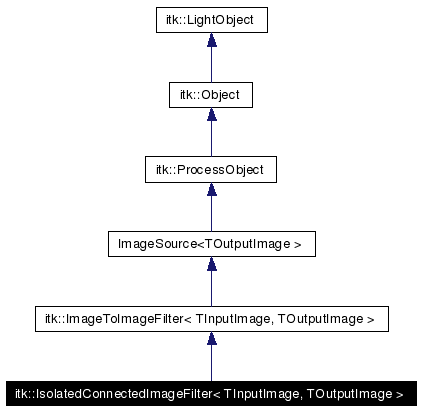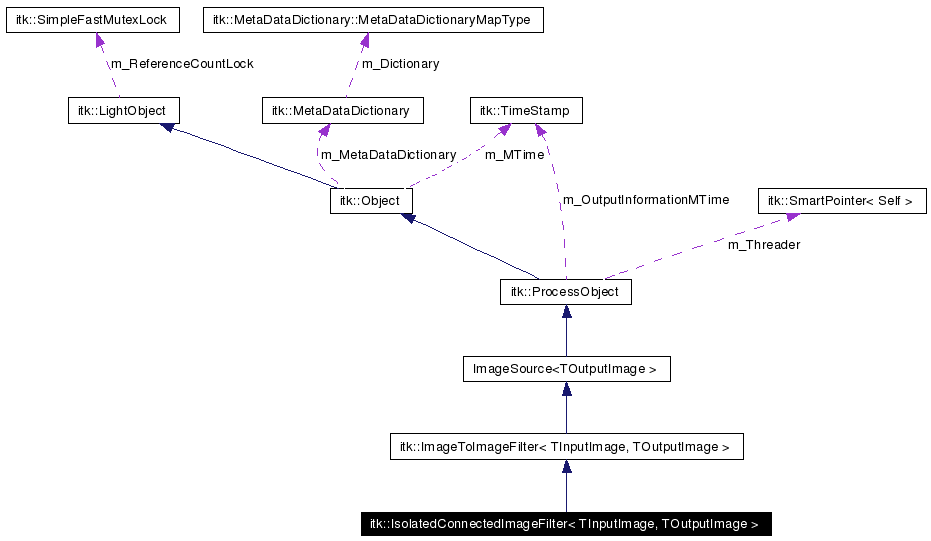
#include <itkIsolatedConnectedImageFilter.h>
Inheritance diagram for itk::IsolatedConnectedImageFilter< TInputImage, TOutputImage >:


/class IsolatedConnectedImageFilter
IsolatedConnectedImageFilter finds the optimal threshold to separate two regions. It has two modes, one to separate dark regions surrounded by bright regions by automatically finding a minimum isolating upper threshold, and another to separate bright regions surrounded by dark regions by automatically finding a maximum lower isolating threshold. The mode can be chosen by setting FindUpperThresholdOn()/Off(). In both cases, the isolating threshold is retrieved with GetIsolatedValue().
The algorithm labels pixels with ReplaceValue that are connected to Seeds1 AND NOT connected to Seeds2. When finding the threshold to separate two dark regions surrounded by bright regions, given a fixed lower threshold, the filter adjusts the upper threshold until the two sets of seeds are not connected. The algorithm uses a binary search to adjust the upper threshold, starting at Upper. The reverse is true for finding the threshold to separate two bright regions. Lower defaults to the smallest possible value for the InputImagePixelType, and Upper defaults to the largest possible value for the InputImagePixelType.
The user can also supply the Lower and Upper values to restrict the search. However, if the range is too restrictive, it could happen that no isolating threshold can be found between the user specified Lower and Upper values. Therefore, unless the user is sure of the bounds to set, it is recommended that the user set these values to the lowest and highest intensity values in the image, respectively.
The user can specify more than one seed for both regions to separate. The algorithm will try find the threshold that ensures that all of the first seeds are contained in the resulting segmentation and all of the second seeds are not contained in the segmentation.
It is possible that the algorithm may not be able to find the isolating threshold because no such threshold exists. The user can check for this by querying the GetThresholdingFailed() flag.
Definition at line 70 of file itkIsolatedConnectedImageFilter.h.
|
|||||
|
Reimplemented from itk::ImageToImageFilter< TInputImage, TOutputImage >. Definition at line 79 of file itkIsolatedConnectedImageFilter.h. |
|
|||||
|
Definition at line 93 of file itkIsolatedConnectedImageFilter.h. Referenced by itk::IsolatedConnectedImageFilter< TInputImage, TOutputImage >::ClearSeeds2(). |
|
|||||
|
Reimplemented from itk::ImageToImageFilter< TInputImage, TOutputImage >. Definition at line 90 of file itkIsolatedConnectedImageFilter.h. |
|
|||||
|
Reimplemented from itk::ImageToImageFilter< TInputImage, TOutputImage >. Definition at line 92 of file itkIsolatedConnectedImageFilter.h. |
|
|||||
|
Reimplemented from itk::ImageToImageFilter< TInputImage, TOutputImage >. Definition at line 89 of file itkIsolatedConnectedImageFilter.h. |
|
|||||
|
Reimplemented from itk::ImageToImageFilter< TInputImage, TOutputImage >. Definition at line 91 of file itkIsolatedConnectedImageFilter.h. |
|
|||||
|
Some convenient typedefs. Reimplemented from itk::ImageToImageFilter< TInputImage, TOutputImage >. Definition at line 88 of file itkIsolatedConnectedImageFilter.h. |
|
|||||
|
Definition at line 104 of file itkIsolatedConnectedImageFilter.h. |
|
|||||
|
Reimplemented from itk::ImageSource< TOutputImage >. Definition at line 99 of file itkIsolatedConnectedImageFilter.h. |
|
|||||
|
Reimplemented from itk::ImageSource< TOutputImage >. Definition at line 97 of file itkIsolatedConnectedImageFilter.h. |
|
|||||
|
Superclass typedefs. Reimplemented from itk::ImageToImageFilter< TInputImage, TOutputImage >. Definition at line 98 of file itkIsolatedConnectedImageFilter.h. |
|
|||||
|
Some convenient typedefs. Reimplemented from itk::ImageSource< TOutputImage >. Definition at line 96 of file itkIsolatedConnectedImageFilter.h. |
|
|||||
|
Reimplemented from itk::ImageToImageFilter< TInputImage, TOutputImage >. Definition at line 78 of file itkIsolatedConnectedImageFilter.h. |
|
|||||
|
Definition at line 101 of file itkIsolatedConnectedImageFilter.h. |
|
|||||
|
Standard class typedefs. Reimplemented from itk::ImageToImageFilter< TInputImage, TOutputImage >. Definition at line 76 of file itkIsolatedConnectedImageFilter.h. |
|
|||||
|
Definition at line 94 of file itkIsolatedConnectedImageFilter.h. |
|
|||||
|
Reimplemented from itk::ImageToImageFilter< TInputImage, TOutputImage >. Definition at line 77 of file itkIsolatedConnectedImageFilter.h. |
|
|||||||||
|
|
|
|||||||||
|
Definition at line 213 of file itkIsolatedConnectedImageFilter.h. |
|
||||||||||
|
Add seed point 1. Definition at line 129 of file itkIsolatedConnectedImageFilter.h. |
|
||||||||||
|
Add seed point 2. Definition at line 155 of file itkIsolatedConnectedImageFilter.h. |
|
|||||||||
|
Clear all the seeds1. Definition at line 121 of file itkIsolatedConnectedImageFilter.h. |
|
|||||||||
|
Clear all the seeds2. Definition at line 147 of file itkIsolatedConnectedImageFilter.h. References itk::IsolatedConnectedImageFilter< TInputImage, TOutputImage >::IndexType. |
|
||||||||||
|
Give the process object a chance to indictate that it will produce more output than it was requested to produce. For example, many imaging filters must compute the entire output at once or can only produce output in complete slices. Such filters cannot handle smaller requested regions. These filters must provide an implementation of this method, setting the output requested region to the size they will produce. By default, a process object does not modify the size of the output requested region. Reimplemented from itk::ProcessObject. |
|
|||||||||
|
Set/Get whether to find an upper threshold (separating two dark regions) or a lower threshold (separating two bright regions). |
|
|||||||||
|
Set/Get whether to find an upper threshold (separating two dark regions) or a lower threshold (separating two bright regions). |
|
|||||||||
|
A version of GenerateData() specific for image processing filters. This implementation will split the processing across multiple threads. The buffer is allocated by this method. Then the BeforeThreadedGenerateData() method is called (if provided). Then, a series of threads are spawned each calling ThreadedGenerateData(). After all the threads have completed processing, the AfterThreadedGenerateData() method is called (if provided). If an image processing filter cannot be threaded, the filter should provide an implementation of GenerateData(). That implementation is responsible for allocating the output buffer. If a filter an be threaded, it should NOT provide a GenerateData() method but should provide a ThreadedGenerateData() instead.
Reimplemented from itk::ImageSource< TOutputImage >. |
|
|||||||||
|
What is the input requested region that is required to produce the output requested region? The base assumption for image processing filters is that the input requested region can be set to match the output requested region. If a filter requires more input (for instance a filter that uses neighborhoods needs more input than output to avoid introducing artificial boundary conditions) or less input (for instance a magnify filter) will have to override this method. In doing so, it should call its superclass' implementation as its first step. Note that imaging filters operate differently than the classes to this point in the class hierachy. Up till now, the base assumption has been that the largest possible region will be requested of the input. This implementation of GenerateInputRequestedRegion() only processes the inputs that are a subclass of the ImageBase<InputImageDimension>. If an input is another type of DataObject (including an Image of a different dimension), they are skipped by this method. The subclasses of ImageToImageFilter are responsible for providing an implementation of GenerateInputRequestedRegion() when there are multiple inputs of different types.
Reimplemented from itk::ImageToImageFilter< TInputImage, TOutputImage >. |
|
|||||||||
|
Set/Get whether to find an upper threshold (separating two dark regions) or a lower threshold (separating two bright regions). |
|
|||||||||
|
Get value that isolates the two seeds. |
|
|||||||||
|
Set/Get the precision required for the intensity threshold value. The default is 1. |
|
|||||||||
|
Set/Get the limit on the lower threshold value. The default is the NonpositiveMin() for the InputPixelType. |
|
|||||||||
|
Run-time type information (and related methods). Reimplemented from itk::ImageToImageFilter< TInputImage, TOutputImage >. |
|
|||||||||
|
Set/Get value to replace thresholded pixels. Pixels that lie within the thresholds will be replaced with this value. The default is 1. |
|
|||||||||
|
Get the flag that tells whether the algorithm failed to find a threshold. |
|
|||||||||
|
Set/Get the limit on the upper threshold value. The default is the max() for the InputPixelType. |
|
|||||||||
|
Set/Get the limit on the upper threshold value. The default is the max() for the InputPixelType. These methods have been deprecated. Please use Set/Get Upper instead. Definition at line 179 of file itkIsolatedConnectedImageFilter.h. |
|
|||||||||
|
Method for creation through the object factory. Reimplemented from itk::Object. |
|
||||||||||||||||
|
Methods invoked by Print() to print information about the object including superclasses. Typically not called by the user (use Print() instead) but used in the hierarchical print process to combine the output of several classes. Reimplemented from itk::ImageToImageFilter< TInputImage, TOutputImage >. |
|
||||||||||
|
Set/Get whether to find an upper threshold (separating two dark regions) or a lower threshold (separating two bright regions). |
|
||||||||||
|
Set/Get the precision required for the intensity threshold value. The default is 1. |
|
||||||||||
|
Set/Get the limit on the lower threshold value. The default is the NonpositiveMin() for the InputPixelType. |
|
||||||||||
|
Set/Get value to replace thresholded pixels. Pixels that lie within the thresholds will be replaced with this value. The default is 1. |
|
||||||||||
|
Set seed point 1. This seed will be isolated from Seed2 (if possible). All pixels connected to this seed will be replaced with ReplaceValue. This method is deprecated, please use AddSeed() Definition at line 112 of file itkIsolatedConnectedImageFilter.h. |
|
||||||||||
|
Set seed point 2. This seed will be isolated from Seed1 (if possible). This method is deprecated, please use AddSeed() Definition at line 138 of file itkIsolatedConnectedImageFilter.h. |
|
||||||||||
|
Set/Get the limit on the upper threshold value. The default is the max() for the InputPixelType. |
|
||||||||||
|
Set/Get the limit on the upper threshold value. The default is the max() for the InputPixelType. These methods have been deprecated. Please use Set/Get Upper instead. Definition at line 175 of file itkIsolatedConnectedImageFilter.h. |
|
|||||
|
Definition at line 221 of file itkIsolatedConnectedImageFilter.h. |
|
|||||
|
Definition at line 219 of file itkIsolatedConnectedImageFilter.h. |
|
|||||
|
Definition at line 220 of file itkIsolatedConnectedImageFilter.h. |
|
|||||
|
Definition at line 216 of file itkIsolatedConnectedImageFilter.h. |
|
|||||
|
Definition at line 218 of file itkIsolatedConnectedImageFilter.h. |
|
|||||
|
Definition at line 214 of file itkIsolatedConnectedImageFilter.h. |
|
|||||
|
Definition at line 215 of file itkIsolatedConnectedImageFilter.h. |
|
|||||
|
Definition at line 222 of file itkIsolatedConnectedImageFilter.h. |
|
|||||
|
Definition at line 217 of file itkIsolatedConnectedImageFilter.h. |
 1.3.5 written by Dimitri van Heesch,
© 1997-2000
1.3.5 written by Dimitri van Heesch,
© 1997-2000